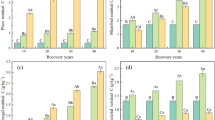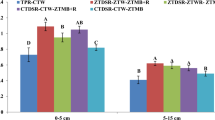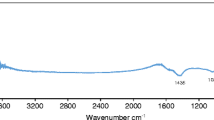Abstract
Surface (0–15 cm) and subsurface (30–45 cm) soil samples from under canopy, edge of canopy and away from canopy of isolated Cordia africana Lam. and Croton macrostachyus Del. trees and their leaves were examined to investigate leaf nutrient content, root biomass and the contribution of trees on farms to soil fertility parameters in Badessa area, eastern Ethiopia. Leaves of C. macrostachyus had 20% higher P and 25% lower K contents than those of C. africana. The studied species had comparable leaf N content. Both species produced shallow lateral roots that extended beyond the canopy zone. Typically, higher fine root biomass was observed in the surface soils than the subsurface soils. Both species did not affect soil organic C, pH and cation exchange capacity. Surface and subsurface soils under tree canopies had 22–26 and 12–17% higher N, respectively, than the corresponding soils away from tree canopies. Surface soil available P under tree canopies was 34–50% higher than the corresponding soil away from canopies. Available P content of subsurface soil was improved only under C. africana canopy. The available P of surface soil under C. macrostachyus canopy was more than double that for C. africana. Trees of both species increased underneath surface and subsurface exchangeable K by 18–46% compared with the corresponding controls. In conclusion, C. macrostachyus and C. africana trees on farms keep soil nutrient high via protection against leaching, translocation of nutrients from deeper to the surface layer and accumulation of litter, which create a temporary nutrient pool in the surface soils under their canopies.


Similar content being viewed by others
References
Anderson JM, Ingram JSI (1993) Tropical soil biology and fertility: a handbook of methods, 2nd edn. CAB International, UK
Ashagrie Y, Mamo T, Olsson M (1999) Changes in some soil chemical properties under scattered Croton macrostachyus trees in the traditional agroforestry system in northwestern Ethiopia. Ethiop J Nat Resour 1:215–233
EFAP (1994) Ethiopian Forestry Action Program. Draft final report vol II. The challenge for development. Ministry of Natural Resources and Environmental Protection, Addis Ababa
EMA (1981) National atlas of Ethiopia. Ethiopian Mapping Agency, Addis Ababa
Gindaba J, Rozanov A, Negash L (2004a) Response of seedlings of two Eucalyptus and three deciduous tree species from Ethiopia to severe water stress. For Ecol Manag 201:119–129
Gindaba J, Olsson M, Itanna F (2004b) Nutrient composition and short-term release from Croton macrostachyus Del. and Millettia ferruginea (Hoechst.) Baker leaves. Biol Fertil Soils 40:393–397
Gindaba J, Rozanov A, Negash L (2005) Photosynthetic gas exchange, growth and biomass allocation of two Eucalyptus and three indigenous tree species of Ethiopia under moisture deficit. For Ecol Manag 205:127–138
Edwards S, Mesfin T, Hedberg I (1995) Flora of Ethiopia and Eritrea, vol. 2. Part 2, Canellaceae to Euphorbiaceae. Addis Ababa University Press, Sweden
Hailu T, Negash L, Olson M (2000) Millettia ferruginea from southern Ethiopia: impact on soil fertility and growth of maize. Agrofor Syst 48:9–24
Murphy HF (1968) A report on the fertility status and other data on some soils of Ethiopia. College of Agriculture, Haile Selassie I University. Exp Stn Bull 44:100–255
Mwiinga RD, Kwesiga FR, Kamara CS (1994) Decomposition of leaves of six multipurpose tree species in Chipata, Zambia. For Ecol Manag 64:209–216
Nair PKR (1993) An introduction to agroforestry. Kluwer, The Netherlands
Negash L (1995) Indigenous trees of Ethiopia: biology, uses and propagation techniques. SLU Reprocentralen, Umea, Sweden
Nyberg G (2001) Carbon and nitrogen dynamics in agroforestry systems. Temporal patterns of some important soil processes. Doctoral thesis, Acta Universitatis Agriculturae Sueciae Silvestria 181. Department of Forest Ecology, SLU, Sweden
Nyberg G, Högberg P (1995) Effects of young agroforestry trees on soils in on-farm situations in western Kenya. Agrofor Syst 32:45–52
Poschen P (1986) An evaluation of the Acacia albida-based agroforestry practices in the Harerghe highlands of Eastern Ethiopia. Agrofor Syst 4:129–143
Poschen P (1987) The application of farming systems research to community forestry: a case study in the Hararge highlands, Eastern Ethiopia. In: Knuth D (ed) Tropical agriculture, vol. 1. TRIOPS Verlag, Langen, Germany, pp 1–250
Rowell DL (1994) Soil science: methods and applications. Longman, UK
Schroth G, Zech W (1995) Root length dynamics in agroforestry with Gliricidia sepium as compared to sole cropping in the semi deciduous rainforest zone of West Africa. Plant Soil 170:297–306
Teketay D, Tegenie A (1991) Shade trees of coffee in Harerghe, eastern Ethiopia. Int Tree Crops J 7:17–27
Teklay T, Malmer A (2004) Decomposition of leaves from two indigenous trees of contrasting qualities under shaded-coffee and agricultural land-uses during the dry season at Wondo Genet, Ethiopia. Soil Biol Biochem 36:777–786
Van Noordwijk M, Lawson G, Soumare A, Groot JJR, Hairiah K (1996) Root distribution of trees and crops: competition and/or complementarity. In: Ong CK, Huxley PA (eds) Tree-crop interactions—a physiological approach. CAB International, Wallingford, UK, pp 319–369
Yadessa A, Itanna F, Olsson M (2001) Contribution of indigenous trees to soil properties: the case of scattered trees of Cordia africana Lam. in croplands of western Oromia. Ethiop J Nat Resour 3:245–270
Young A (1997) Agroforestry for soil management, 2nd edn. CAB International, Wallingford, UK
Acknowledgements
This study was supported by the Agricultural Research and Training Project (ARTP) of the Alemaya University (Ethiopia). We are grateful to the staff of the Kuni District Agriculture and Natural Resources Department for their assistance during the study and all the farmers in Kara and Oda Muda peasant associations who allowed the study to be carried out on their farms.
Author information
Authors and Affiliations
Corresponding author
Rights and permissions
About this article
Cite this article
Gindaba, J., Rozanov, A. & Negash, L. Trees on farms and their contribution to soil fertility parameters in Badessa, eastern Ethiopia. Biol Fertil Soils 42, 66–71 (2005). https://doi.org/10.1007/s00374-005-0859-2
Received:
Revised:
Accepted:
Published:
Issue Date:
DOI: https://doi.org/10.1007/s00374-005-0859-2




